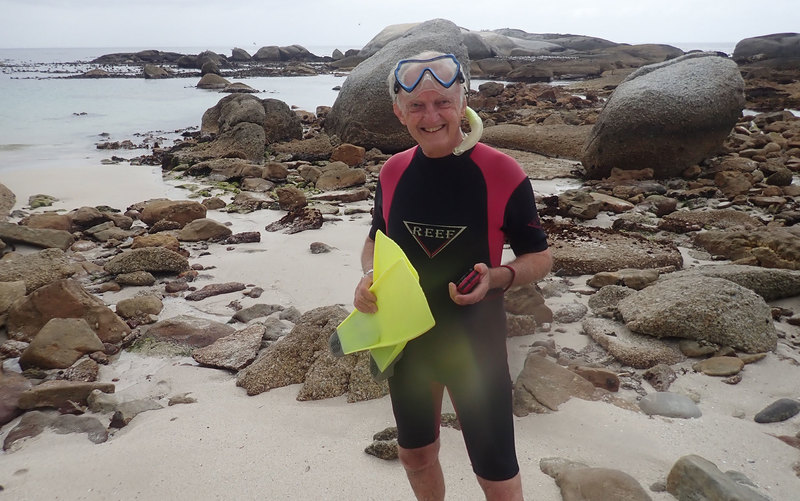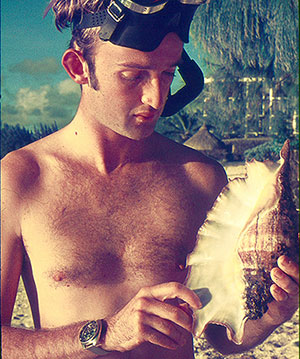Fifty years of brine and biology
14 February 2020 | Story Helen Swingler. Read time 8 min.
This year emeritus professor and senior scholar Charles Griffiths celebrates 50 years as a salaried member of staff at the University of Cape Town (UCT). In this time the doyen of marine biology has added more than 300 species to the known marine fauna of Southern Africa, over 100 of which are new to science. And he’s not stopping there. He spoke with Helen Swingler.
Helen Swingler (HS): Describe those early UCT days. What was your first job?
Charles Griffiths (CG): My first appointment was as a research assistant in the then Council for Scientific and Industrial Research (CSIR) Marine Research Unit where my duties were to maintain the marine collections and catalogues and to conduct taxonomic research, which I later used for my PhD. The CSIR Marine Research Unit was housed in the Department of Oceanography and I was funded through them, although my office was in zoology. The salary was R2 500 per year, about which I was extremely happy! My shared rent for a spacious Gardens apartment was R30 a month, food cost another R30 a month and I was soon able to afford a second-hand Ford Cortina. I used to purchase R1 of petrol at a time!
HS: Where did the most transformation in your field occur in these five decades?
CG: In terms of working life, by far the most transformative changes have been in the fields of communication technology. Back in the 1970s personal computers, email, the internet, cellular phones and the like were undreamed of and even TV had yet to reach South Africa. Communication was by post (snail mail) and very few academics could type, so letters and papers were usually hand-written, then typed up by secretaries. Senior executives dictated letters and their secretaries either transcribed them in shorthand or typed them from Dictaphone recordings.
HS: That must have bedevilled quick communications. What about research and publications?
CG: Research findings were disseminated almost entirely by means of hard copy journals, and it was part of academic life to make a weekly trip to the library to scan the contents pages of the latest journals and to photocopy important articles. Indeed, contents pages were photocopied by library staff and circulated to the relevant departments. The departmental secretary then attached a staff list to each set, or any other circulated documents, and placed these in the first person’s post box. When they’d examined the document, they ticked off their name and passed on to the next staff member. Circulars could thus take weeks to make the rounds. Other more urgent announcements about upcoming seminars, conferences or events were posted on the tearoom notice board.

HS: How were research papers disseminated and gathered?
CG: The procedure was to write a postcard to the author requesting a physical reprint. For this, special pre-printed cards, complete with tear-off return address slips, were available in every department. One would fill in a card, mail it off and perhaps get a response in two to four weeks, providing the author still had reprints and was willing to place them in an envelope and post them back. Authors of papers normally received 50 complimentary copies for dissemination and once these were depleted, they either photocopied more, or simply ignored further requests.
HS: And drafts of research papers were handwritten until the final version?
CG: As there was no word processing, papers didn’t develop through the current evolutionary process of repeated redrafting, cutting and pasting, etc. The full paper had to be written continuously in longhand. If too much editing was done on the manuscript, it became very difficult for the secretary to accurately type it out. Manuscripts were then usually retyped in their entirety at least three more times. The draft would be circulated to supervisors, co-authors and/or colleagues, and then a clean copy had to be retyped and photocopied for submission. These postally submitted copies would then be posted (by snail mail again) to referees who would annotate corrections and changes by hand and post these back to the editor who then posted them on again to the author. Another clean copy would then have to be typed for final journal submission.
HS: Hooray!
CG: That wasn’t the end of the story, though, as the journal still had to retype the entire manuscript yet again into a typesetting machine for publication. Illustrations were drawn by hand using a draftsman’s technical drawing board and ink pens. Lettering was applied one letter at a time using either a carefully aligned and spaced stencil or Letraset (sheets of self-adhesive lettering). Letraset was extremely expensive and each sheet purchased came in one specific font and font size, so a researcher would often quickly use up specific letters from the sheets. Much time would then be spent trying to find someone who still had some 14 pt Times New Roman capital B’s in their Letraset collection, for example.
HS: So much for publish, publish, publish …
CG: Looking back from our modern world of instant global communication, it’s hard to imagine how we managed under these conditions, but in fact productivity and publication rates were similar to those today. Perhaps that is because we had fewer distractions, original research was easier to do and administrative loads were much lighter.
HS: How have the methods and focus of research changed?
CG: The field methods used to gather data for the types of ecological and taxonomic research I specialise in have changed remarkably little over the decades (we still use the same types of grabs, dredges or trawls to collect deep water samples, and similar techniques to gather intertidal samples or dissect specimens).This is in marked contrast to other branches of marine science where technology has totally transformed the quantity and accuracy of collection of physical and chemical data, has permitted satellite tracking of animals, genetic analysis of population structure, etc. New topics have also, of course, become topical, perhaps most notably climate change and other anthropogenic impacts, such as plastic pollution.
HS: How do you view your legacy as a doyen of marine biology research?
CG: I definitely planned the legacy that I wished to leave and am most proud of three things. First, I’ve trained over 80 master’s and PhD students, many of whom have gone on to become academics or leading researchers themselves and thus become the next generation of prominent marine scientists. Second, I am an author of the standard guidebooks describing marine life in Southern Africa, freshwater life in the region and of the largest group of terrestrial animals (insects) of the region. Third, I’ve added more than 300 species to the known fauna of the region, over 100 of which are new to science.
HS: Would you do it all over again?
CG: Definitely a no-brainer. I feel incredibly blessed to have lived the life that I was lucky enough to fall into and regret nothing.
HS: What do our young marine biologists need to be most aware of working and researching at the foot of Africa.
CG: This is certainly one of the best places in the world to be a marine biologist, as we sit in a uniquely biodiverse site at the junction of three of the world’s great oceans, but also where the wealth of marine life has been poorly explored. Unlike most other high-biodiversity sites, we also have excellent research facilities and colleagues to work with.
HS: What are you working on now?
CG: One of my greatest thrills is finding and describing new species, and I have several more in various stages of description. I also love writing field guides and macro-photography and am currently co-authoring a guidebook to Southern African moths of which there are over 10 000 known species.
 This work is licensed under a Creative Commons Attribution-NoDerivatives 4.0 International License.
This work is licensed under a Creative Commons Attribution-NoDerivatives 4.0 International License.
Please view the republishing articles page for more information.
Research & innovation





































